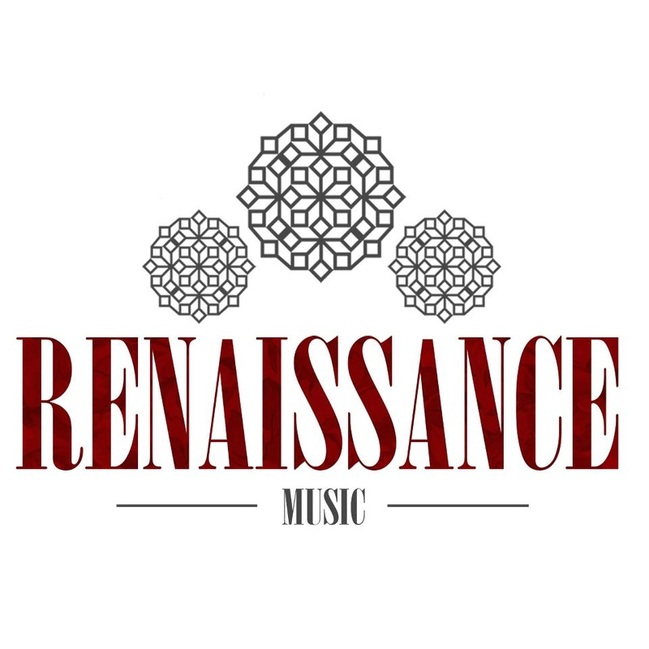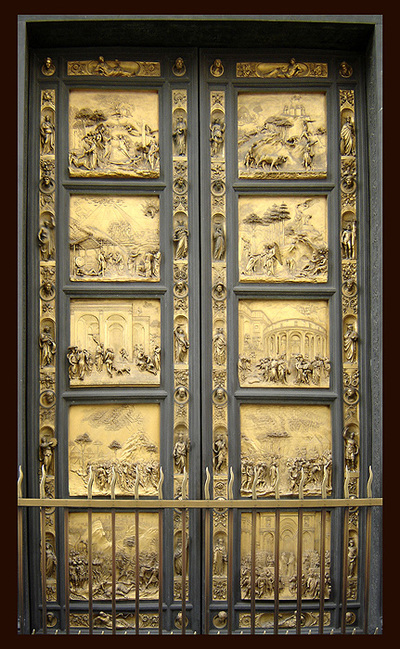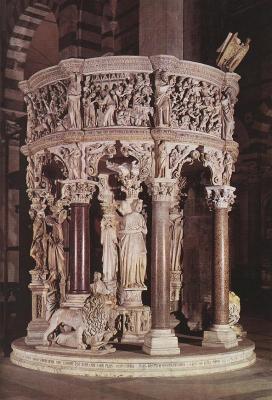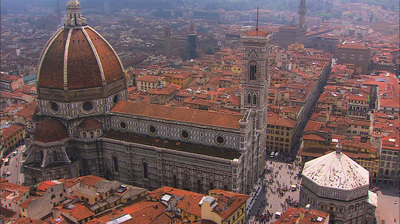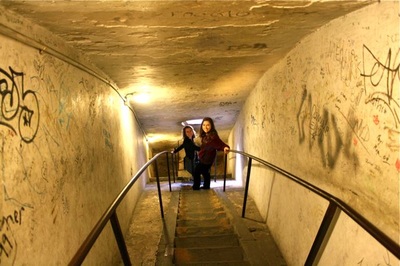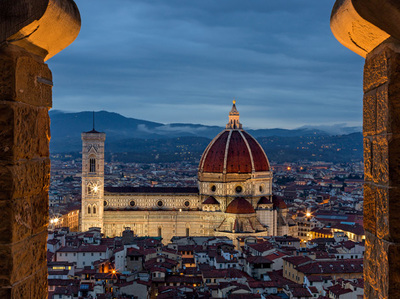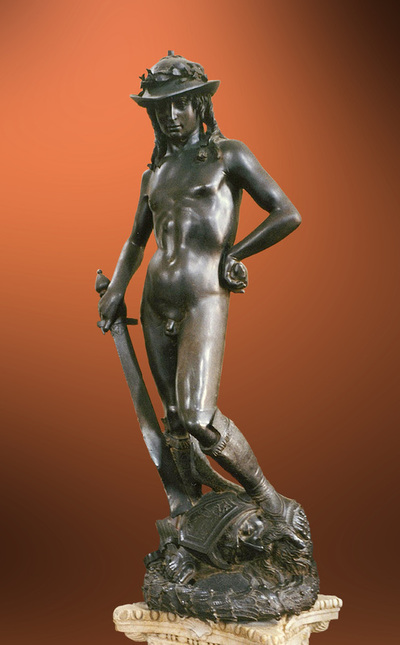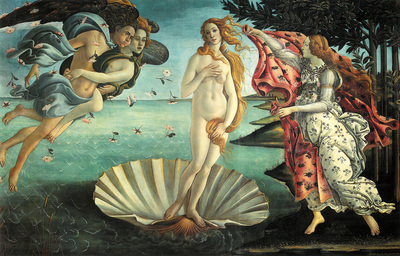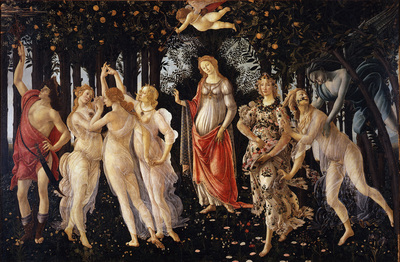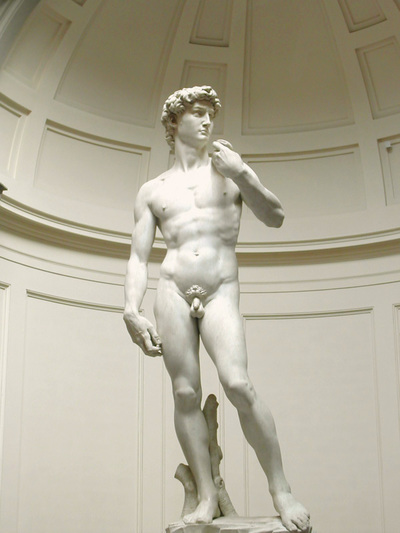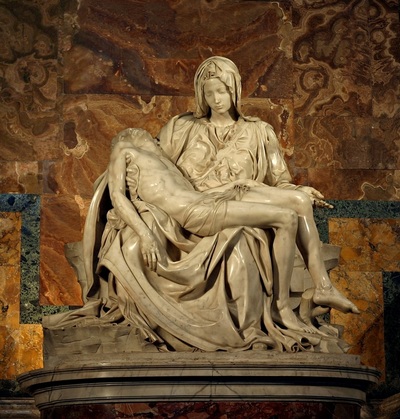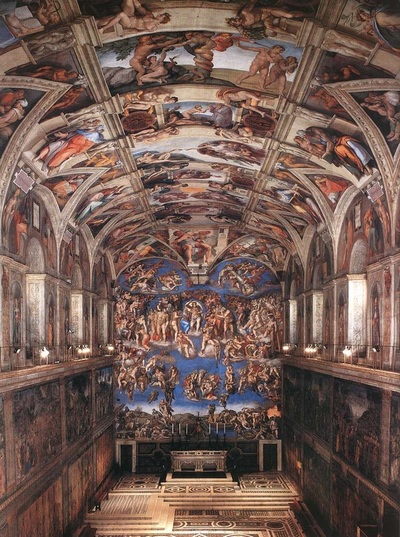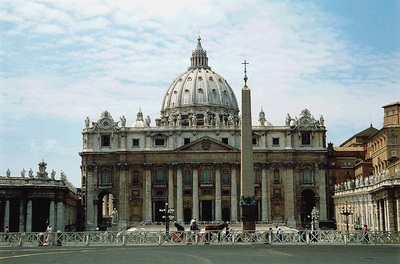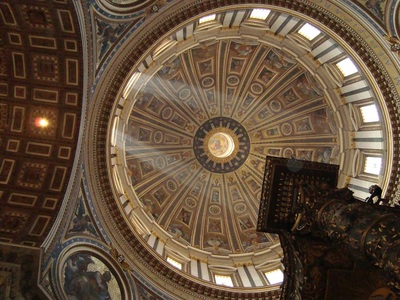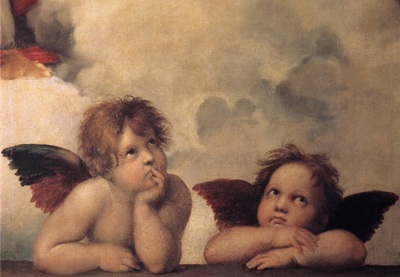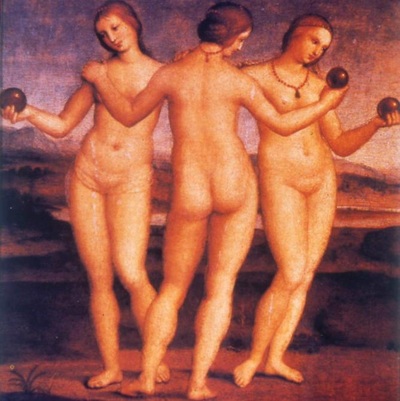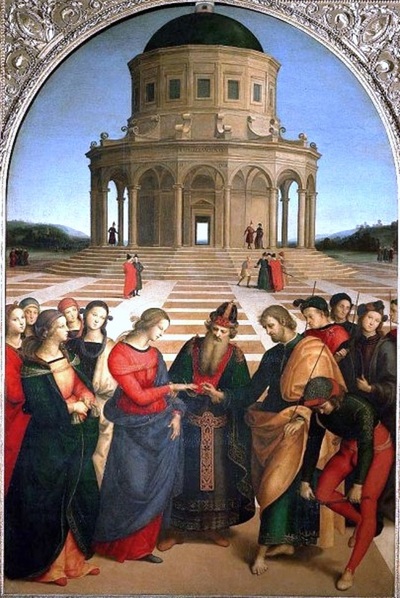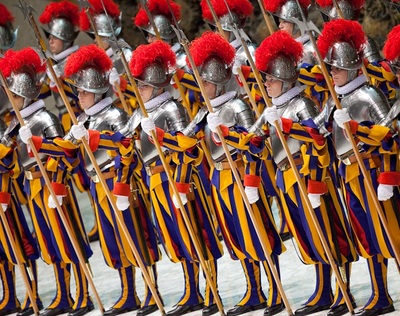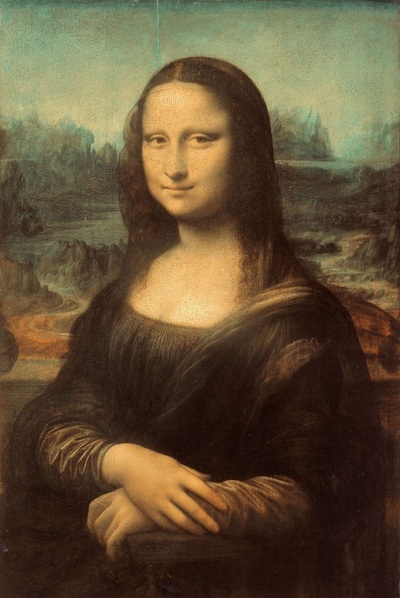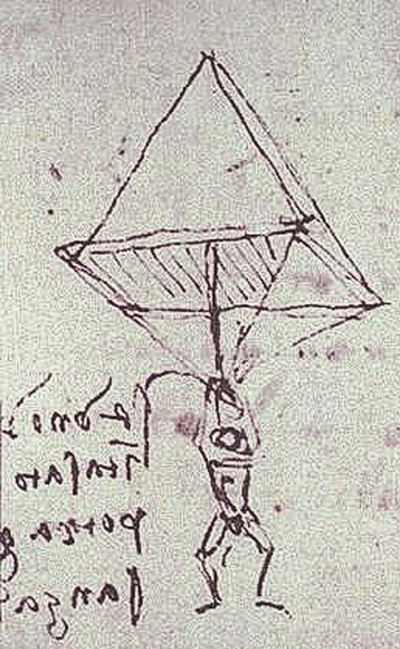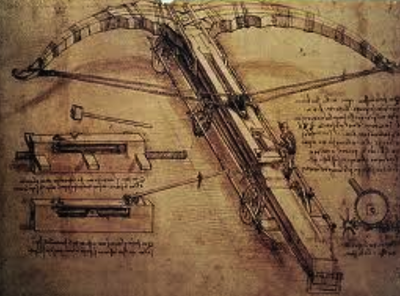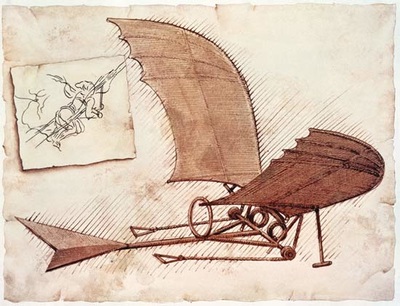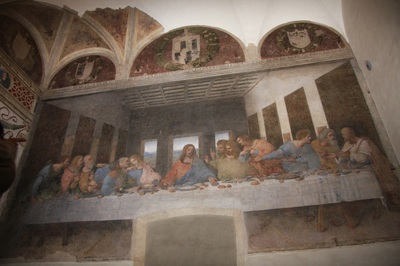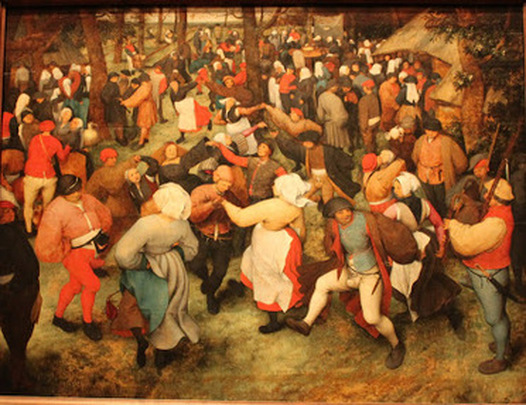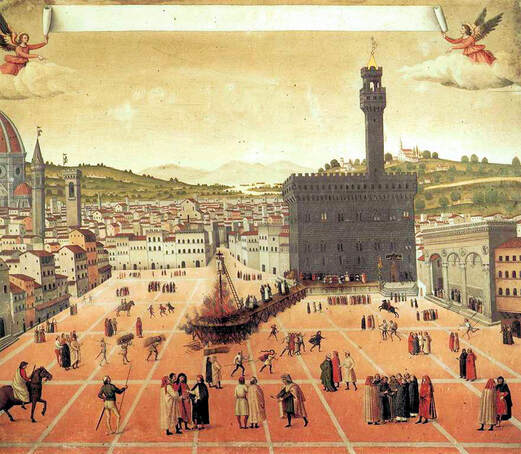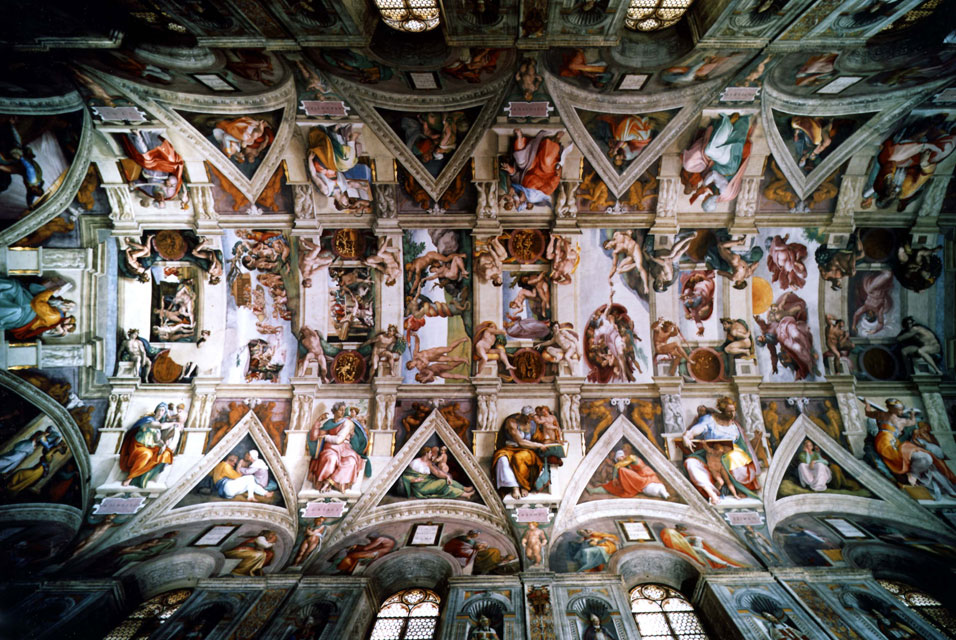Lecture #3:
The Renaissance
1400-1600
The Renaissance
1400-1600
___________________________________________________________________
Pre-Lecture Notes
The first study of music as an art form dates from around 500 B.C., when Pythagoras experimented with acoustics and the mathematical relationships of tones (we'll discuss that later). In so doing, Pythagoras and others established the Greek modes: scales comprised of whole tones and half steps.
*Click here for Youtube of Tetrachords and major scale.
*Click here for Youtube Greek Modes
Pre-Lecture Notes
The first study of music as an art form dates from around 500 B.C., when Pythagoras experimented with acoustics and the mathematical relationships of tones (we'll discuss that later). In so doing, Pythagoras and others established the Greek modes: scales comprised of whole tones and half steps.
*Click here for Youtube of Tetrachords and major scale.
*Click here for Youtube Greek Modes
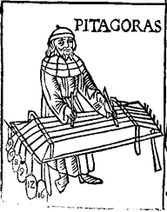
HARMONY: Two or more tones sounded at the same time
A couple of examples of "overtone" harmony.
Bernstein explains overtone series
(or ClassRoom Example)
Voice overtone singing (CLICK)
A couple of examples of "overtone" harmony.
Bernstein explains overtone series
(or ClassRoom Example)
Voice overtone singing (CLICK)
_______________________________________________
Major Scale: 2 Tetrachords separated by a whole step
WWH (W) WWH
Major Scale: 2 Tetrachords separated by a whole step
WWH (W) WWH
The History Channel: Middle Ages
View "The Crusades" (4 min.)
View "The Black Death" (6 min)
_______________________________________________________
View "The Crusades" (4 min.)
View "The Black Death" (6 min)
_______________________________________________________
1400-1600
LECTURE Renaissance

Text Starts Here
(Canvas quiz is taken from this text)
The Renaissance
1400-1600
The Renaissance was a time of rebirth in Europe's learning, science, and the arts. The rediscovery of the writings of ancient Greece and Rome led to a renewed interest in learning in general. The invention of the printing press allowed the unprecedented disbursement of this knowledge.
The invention of the compass permitted the navigation of the world's oceans and the subsequent discovery of lands far removed from the European continent. With Copernicus' discovery of the actual position of the earth in the solar system and Martin Luther's Protestant Reformation, the Catholic Church lost its grip on society, and a humanist spirit was born. This spirit manifested itself in the painting and sculpture of Michelangelo, the plays of Shakespeare, and in both the sacred and secular dance and vocal music of the greatest composers of the era.
Intro to the Renaissance (humanism start at 3:00)
Florence: The Heart of the Renaissance (in class 1:33-5:02)
Renaissance Music Overview
Galileo Galilei short bio
(Canvas quiz is taken from this text)
The Renaissance
1400-1600
The Renaissance was a time of rebirth in Europe's learning, science, and the arts. The rediscovery of the writings of ancient Greece and Rome led to a renewed interest in learning in general. The invention of the printing press allowed the unprecedented disbursement of this knowledge.
The invention of the compass permitted the navigation of the world's oceans and the subsequent discovery of lands far removed from the European continent. With Copernicus' discovery of the actual position of the earth in the solar system and Martin Luther's Protestant Reformation, the Catholic Church lost its grip on society, and a humanist spirit was born. This spirit manifested itself in the painting and sculpture of Michelangelo, the plays of Shakespeare, and in both the sacred and secular dance and vocal music of the greatest composers of the era.
Intro to the Renaissance (humanism start at 3:00)
Florence: The Heart of the Renaissance (in class 1:33-5:02)
Renaissance Music Overview
Galileo Galilei short bio
Innovations and Inventions of the Renaissance Music/Video
MUSIC: Mason Williams "Classical Gas"
RENAISSANCE TIMELINE HIGHLIGHTS
1300 The first mechanical clock.
1366 Scales for weighing.
1400 First golf ball was invented.
The first piano called the Spinet invented.
1450 Lenses for near-sighted people invented.
1456 Printing press by Gutenberg in Germany.
1475 Muzzle loaded rifles invented in Italy.
1485 Leonardo da Vinci designed the first parachute.
1487 Bell chimes.
1494 Whiskey in Scotland.
1500 The first flush toilets were invited.
1509 Henry VIII becomes King of England.
1510 Pocket watch invented.
1514 Nicolaus Copernicus established the fact that the center of the universe is not the Earth.
1517 Martin Luther posts 95 theses on Wittenberg (Germany) church door.
1529 Henry VIII begins to cut ties with Church in Rome, set up Church of England.
1568 Bottled beer was invented in London.
1589 Knitting machine invented.
1590 Compound microscope invented.
1593 Galileo Galilei invented the water thermometer.
1599 Globe Theater becomes Shakespeare's home
1608 First telescope was invented.
1624 Slide Rule was invented.
1625 Method of blood transfusion was invented.
1642 Adding Machine invented.
1643 Barometer invented.
1650 The first air pump.
1656 The pendulum clock was invented.
1660 The cuckoo clock was first made in Black Forest, Germany.
1670 Champagne was invented by Dom Perignon.
1671 Sir Isaac Newton publishes his major work which contains the three laws of motion and the law of universal gravitation.
1679 Pressure cooker invented
1698 Steam pump invented
Outside Reading: National Geo's online article on Brunelleschi's Dome in Florence
Renaissance
(1400-1600)
The Renaissance may be described as an age of
Due to the church's loss of power and new humanistic ideas, musical activity gradually shifted from the church to the court. Education was considered a status symbol by aristocrats and the upper middle class, and every educated person was expected to be trained in music.
Musically, the Renaissance period is sometimes called the golden age of acapella choral music because the music did not need instrumental accompaniment. The texture of the Renaissance music is chiefly polyphonic. Renaissance composers often used word painting, a musical representation of specific poetic images.
Certain elements made Renaissance music sound fuller than medieval music:
-Composers considered the harmonic effect of chords rather than superimposing one melody above another.
-Typical choral pieces have four, five, or six voice parts of nearly equal melodic interest.
-Renaissance melodies are usually A Capella, which refers to unaccompanied choral music.
SACRED MUSIC:
The two primary forms of sacred Renaissance Music are the mass and the motet
The Motet is a polyphonic choral work set to a sacred Latin text other than the mass.
The Council of Trent attacked Renaissance church music because it used secular tunes, noisy instruments, and theatrical singing. Based on its deliberations, the Council of Trent attempted to purify Catholic Church music.
SECULAR MUSIC
-Renaissance secular vocal music was written for groups of solo voices and solo voices with instrumental accompaniment.
-Secular music contained more rapid changes of mood than sacred music.
-A wealth of dance music published during the sixteenth century has survived.
The Madrigal
-Is a vocal composition that combines several music textures.
-The madrigal is a piece for several voices set to a short poem, usually about love.
-The Renaissance Madrigal began around 1520 in Italy.
-It differs from the motet in using a vernacular rather than Latin text.
-It also differs from the motet in its often use of word painting and unusual harmonies.
-The development of the English Madrigal can be traced to 1588 and is considered a result of the publication of a volume of translated Italian madrigals in London.
INSTRUMENTAL MUSIC:
-Much of the instrumental music composed during the Renaissance was intended for dancing.
-Lute: A versatile plucked string instrument with a body shaped like half a pear, was popular during the Renaissance.
(1400-1600)
The Renaissance may be described as an age of
- Curiosity and individualism,
- Exploration and Adventure,
- The rebirth of human creativity.
Due to the church's loss of power and new humanistic ideas, musical activity gradually shifted from the church to the court. Education was considered a status symbol by aristocrats and the upper middle class, and every educated person was expected to be trained in music.
Musically, the Renaissance period is sometimes called the golden age of acapella choral music because the music did not need instrumental accompaniment. The texture of the Renaissance music is chiefly polyphonic. Renaissance composers often used word painting, a musical representation of specific poetic images.
Certain elements made Renaissance music sound fuller than medieval music:
-Composers considered the harmonic effect of chords rather than superimposing one melody above another.
-Typical choral pieces have four, five, or six voice parts of nearly equal melodic interest.
-Renaissance melodies are usually A Capella, which refers to unaccompanied choral music.
SACRED MUSIC:
The two primary forms of sacred Renaissance Music are the mass and the motet
The Motet is a polyphonic choral work set to a sacred Latin text other than the mass.
The Council of Trent attacked Renaissance church music because it used secular tunes, noisy instruments, and theatrical singing. Based on its deliberations, the Council of Trent attempted to purify Catholic Church music.
SECULAR MUSIC
-Renaissance secular vocal music was written for groups of solo voices and solo voices with instrumental accompaniment.
-Secular music contained more rapid changes of mood than sacred music.
-A wealth of dance music published during the sixteenth century has survived.
The Madrigal
-Is a vocal composition that combines several music textures.
-The madrigal is a piece for several voices set to a short poem, usually about love.
-The Renaissance Madrigal began around 1520 in Italy.
-It differs from the motet in using a vernacular rather than Latin text.
-It also differs from the motet in its often use of word painting and unusual harmonies.
-The development of the English Madrigal can be traced to 1588 and is considered a result of the publication of a volume of translated Italian madrigals in London.
INSTRUMENTAL MUSIC:
-Much of the instrumental music composed during the Renaissance was intended for dancing.
-Lute: A versatile plucked string instrument with a body shaped like half a pear, was popular during the Renaissance.
Below: Jessye Norman / Word Painging in Renaissance Music

_____________________________________________________________________________________________
1.
Dance music of the RenaissanceThroughout the Renaissance, instrumental dance music flowered and thrived and was composed, or more likely improvised, by many people. Musicians whose names have come down to us collected much of this existing music and had it published in various volumes over the years. Several examples are featured below. Later, composers modified and developed many of these dance forms and found their way into the Baroque dance suite.
Series of court dances from "The Tudors" (features Henry VIII and several wives).
Elizabeth (daughter of Henry VIII and Anne Boleyn) and the Earl of Leicester dance the Volta at court.
Court dance update #1...(start at :53).
Court dance update #2...(1:00-1:50).
Dance music of the RenaissanceThroughout the Renaissance, instrumental dance music flowered and thrived and was composed, or more likely improvised, by many people. Musicians whose names have come down to us collected much of this existing music and had it published in various volumes over the years. Several examples are featured below. Later, composers modified and developed many of these dance forms and found their way into the Baroque dance suite.
Series of court dances from "The Tudors" (features Henry VIII and several wives).
Elizabeth (daughter of Henry VIII and Anne Boleyn) and the Earl of Leicester dance the Volta at court.
Court dance update #1...(start at :53).
Court dance update #2...(1:00-1:50).

2.
Music of the Church in the
Golden Age of Polyphony
What is Polyphonic Music?
Example #1
Example #2
Example #3
Josquin des Prez
Born: Hainault or Henegouwen (Burgundy), c. 1440
Died: Condé-sur-Escaut, August 27, 1521
Not much is known about the life of Josquin des Prez. Still, it is generally agreed that he studied under the earlier Renaissance master Johannes Ockeghem (c.1420-1495), who was the first great master of the Flemish school of Renaissance composers. There are references to Josquin's having served at several courts in Italy and France and at the Sistine Chapel in Rome. He died while serving as canon of the collegiate church at Condé. Among his surviving works are over a dozen masses, a hundred motets, and a good deal of secular music.
The serene, almost otherworldly choral sound of the Flemish school's style can be heard in the Gloria from Josquin's Missa L'homme armé. Flemish composers of the time often based the cantus firmus on a popular melody of the day, composing new music for the other voices in counterpoint to the tune. The simultaneous interweaving of several melodic lines (usually four: soprano, alto, tenor, bass) in a musical composition is known as polyphony. Polyphonic music of the Renaissance could be very complex and intricate, often obscuring the text set's words and meaning.
Josquin des Prez's Misesrere mei deus
(Miserere, by Josquin des Prez, is a motet setting of Psalm 51)
L'homme arem
Josquin des Prez's AVE MARIA
Music of the Church in the
Golden Age of Polyphony
What is Polyphonic Music?
Example #1
Example #2
Example #3
Josquin des Prez
Born: Hainault or Henegouwen (Burgundy), c. 1440
Died: Condé-sur-Escaut, August 27, 1521
Not much is known about the life of Josquin des Prez. Still, it is generally agreed that he studied under the earlier Renaissance master Johannes Ockeghem (c.1420-1495), who was the first great master of the Flemish school of Renaissance composers. There are references to Josquin's having served at several courts in Italy and France and at the Sistine Chapel in Rome. He died while serving as canon of the collegiate church at Condé. Among his surviving works are over a dozen masses, a hundred motets, and a good deal of secular music.
The serene, almost otherworldly choral sound of the Flemish school's style can be heard in the Gloria from Josquin's Missa L'homme armé. Flemish composers of the time often based the cantus firmus on a popular melody of the day, composing new music for the other voices in counterpoint to the tune. The simultaneous interweaving of several melodic lines (usually four: soprano, alto, tenor, bass) in a musical composition is known as polyphony. Polyphonic music of the Renaissance could be very complex and intricate, often obscuring the text set's words and meaning.
Josquin des Prez's Misesrere mei deus
(Miserere, by Josquin des Prez, is a motet setting of Psalm 51)
L'homme arem
Josquin des Prez's AVE MARIA
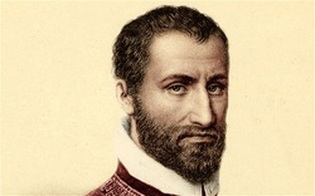
Giovanni Pierluigi da PalestrinaBorn: Palestrina, near Rome, ca. 1525
Died: Rome, February 2, 1594
Palestrina spent much of his career in Rome as an organist and choirmaster at the Sistine Chapel and St. Peter's. He wrote over a hundred mass settings and over two hundred motets as a productive composer. At the same time, he managed a very successful furrier business, from which he died a very wealthy man.
In keeping with the strictures of the Council of Trent (1545-1563) to rid the music of the Catholic rite of the "worldly excesses" of the Protestant Reformation, Palestrina composed in a purer, more restrained style. Gone are the vocal lines based on popular melodies. Instead, each voice part resembles a chant melody, each with its own profile and crystalline line. In the opening Kyrie from Palestrina's most famous work, the Pope Marcellus Mass, one can at once hear the classic, pure lines of the text set clearly amidst the various voices of the choir. Palestrina's polyphonic writing is of such quality that many later composers (including Mozart, Beethoven, and Brahms) spent their early years studying counterpoint in the "Palestrina style" as set down in a famous textbook by J. J. Fux in 1725.
Palestrina's Music in the Vatican (KYRIE from Missa Papae Marcelli)
Died: Rome, February 2, 1594
Palestrina spent much of his career in Rome as an organist and choirmaster at the Sistine Chapel and St. Peter's. He wrote over a hundred mass settings and over two hundred motets as a productive composer. At the same time, he managed a very successful furrier business, from which he died a very wealthy man.
In keeping with the strictures of the Council of Trent (1545-1563) to rid the music of the Catholic rite of the "worldly excesses" of the Protestant Reformation, Palestrina composed in a purer, more restrained style. Gone are the vocal lines based on popular melodies. Instead, each voice part resembles a chant melody, each with its own profile and crystalline line. In the opening Kyrie from Palestrina's most famous work, the Pope Marcellus Mass, one can at once hear the classic, pure lines of the text set clearly amidst the various voices of the choir. Palestrina's polyphonic writing is of such quality that many later composers (including Mozart, Beethoven, and Brahms) spent their early years studying counterpoint in the "Palestrina style" as set down in a famous textbook by J. J. Fux in 1725.
Palestrina's Music in the Vatican (KYRIE from Missa Papae Marcelli)
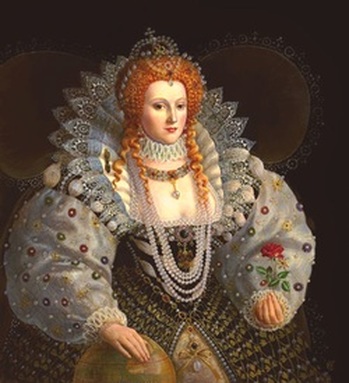
3.
The English Madrigalists
Around 1600 in England, composers and poets collaborated on a body of music known as the English madrigal. Many of these compositions were intended for entertaining at social gatherings. The composer and lutenist John Dowland (1563-1626), although mainly concentrating on melancholy ayres for solo voice with lute accompaniment, also wrote madrigals.
Some of the best known of the English madrigalists include Thomas Morley (1558-1602), Francis Pilkington (ca.1570-1638), William Byrd (1543-1623), Orlando Gibbons(1583-1625), and Thomas Weelkes (1576-1623). Queen Elizabeth I herself was an accomplished lute player, supposedly delighted in the songs and ayres of the madrigalists. Weelkes' madrigal Come, let's begin to revel't out is a prime example of this cheerful and sprightly part-song. The texts of many of these madrigals, however, deal with spurned or unrequited love and are often sad but very beautiful.
Thomas Morley's NOW IS THE MONTH OF MAYING
Monteverdi's ALTRI CANTI D'AMOR, TENERO ARCERO fromMadrigal Book VIII (:00-3:20)
__________________________________________________
The English Madrigalists
Around 1600 in England, composers and poets collaborated on a body of music known as the English madrigal. Many of these compositions were intended for entertaining at social gatherings. The composer and lutenist John Dowland (1563-1626), although mainly concentrating on melancholy ayres for solo voice with lute accompaniment, also wrote madrigals.
Some of the best known of the English madrigalists include Thomas Morley (1558-1602), Francis Pilkington (ca.1570-1638), William Byrd (1543-1623), Orlando Gibbons(1583-1625), and Thomas Weelkes (1576-1623). Queen Elizabeth I herself was an accomplished lute player, supposedly delighted in the songs and ayres of the madrigalists. Weelkes' madrigal Come, let's begin to revel't out is a prime example of this cheerful and sprightly part-song. The texts of many of these madrigals, however, deal with spurned or unrequited love and are often sad but very beautiful.
Thomas Morley's NOW IS THE MONTH OF MAYING
Monteverdi's ALTRI CANTI D'AMOR, TENERO ARCERO fromMadrigal Book VIII (:00-3:20)
__________________________________________________

4.
Castrati Singers of Italy
During Italy's 17th and 18th centuries, some 4,000 - 5,000 boys were castrated annually to sing alto in the church choirs. According to Melicow and Pulrang (Urology 3: 663-670, 1974), the prohibition against women singing in the church choir had its origin in the bible: "Let your women keep silence in the churches; for it is not permitted unto them to speak…" (I Corinthians 14:34). Thus, castrated men (castrati) came to sing in the choir, possessing "the chest and lungs of a man with the vocal cords of a woman (Melicow and Pulrang)."
Castrati were considered the greatest singers of all time, dominating opera in Italy for two centuries.
The CastratiThe procedure became common in the 1500s. Private patrons, church fathers, or singing companies would either approach or be approached by the parents of a boy who stood out as the most talented singer in his church choir. This could happen anytime before the main effects of puberty, but most boys were “recruited” at age twelve or younger. It wasn’t a coincidence that the practice of castration flourished in the poorest areas and among the poorest families. Many families were facing starvation, and the opportunities for castrati were staggering. By 1589, castrati were singing for the Pope in the Sistine Chapel and sang in the Sistine Chapel until 1902.
The primary effect of castration is apparent. Today, we know that castration prevents the formation of dihydrotestosterone. This form of testosterone is more potent, having a higher affinity for receptors than regular testosterone. Exposure to the hormone causes male vocal cords to grow 63%. It also causes the thyroid, a gland that sits on the windpipe, to swell and thicken with cartilage into the noticeable bump that we call the Adam’s apple. Remove the testosterone, and according to autopsies performed on castrati, the vocal cords have the exact dimensions as those of a female soprano.
Text Ends Here
More LISTENING EXAMPLES
Music during the Renaissance
(Click to Listen)
1. Dance Music
2. Polyphonic Vocal Music "Salve regina" by Josquin des Prez
3. Polyphonic Vocal Music
"Agnus Dei" from Mass for Pope Marcellus by Giovanni Palestrina
4. English Madrigalists
"The silver Swanne" by Orlando Gibbons - Madrigals
Castrati Singers of Italy
During Italy's 17th and 18th centuries, some 4,000 - 5,000 boys were castrated annually to sing alto in the church choirs. According to Melicow and Pulrang (Urology 3: 663-670, 1974), the prohibition against women singing in the church choir had its origin in the bible: "Let your women keep silence in the churches; for it is not permitted unto them to speak…" (I Corinthians 14:34). Thus, castrated men (castrati) came to sing in the choir, possessing "the chest and lungs of a man with the vocal cords of a woman (Melicow and Pulrang)."
Castrati were considered the greatest singers of all time, dominating opera in Italy for two centuries.
The CastratiThe procedure became common in the 1500s. Private patrons, church fathers, or singing companies would either approach or be approached by the parents of a boy who stood out as the most talented singer in his church choir. This could happen anytime before the main effects of puberty, but most boys were “recruited” at age twelve or younger. It wasn’t a coincidence that the practice of castration flourished in the poorest areas and among the poorest families. Many families were facing starvation, and the opportunities for castrati were staggering. By 1589, castrati were singing for the Pope in the Sistine Chapel and sang in the Sistine Chapel until 1902.
The primary effect of castration is apparent. Today, we know that castration prevents the formation of dihydrotestosterone. This form of testosterone is more potent, having a higher affinity for receptors than regular testosterone. Exposure to the hormone causes male vocal cords to grow 63%. It also causes the thyroid, a gland that sits on the windpipe, to swell and thicken with cartilage into the noticeable bump that we call the Adam’s apple. Remove the testosterone, and according to autopsies performed on castrati, the vocal cords have the exact dimensions as those of a female soprano.
Text Ends Here
More LISTENING EXAMPLES
Music during the Renaissance
(Click to Listen)
1. Dance Music
2. Polyphonic Vocal Music "Salve regina" by Josquin des Prez
3. Polyphonic Vocal Music
"Agnus Dei" from Mass for Pope Marcellus by Giovanni Palestrina
4. English Madrigalists
"The silver Swanne" by Orlando Gibbons - Madrigals
_________________
Renaissance Review
* The Renaissance was a time of rebirth of learning.
* The rediscovery of the writings of ancient Greece and Rome led to a renewed interest in learning
* The invention of the compass permitted the navigation of the world's oceans and the subsequent discovery of lands far
* Copernicus' discovery of the Sun as center of the Univererse
* Humanist spirit was born
* The intellectual movement called humanism focused on human life and its accomplishments
* Musically, the Renaissance period is sometimes called the golden age of acapella polyphonic choral music
* Polyphonic muisic is the simultaneous interweaving of several melodic lines
* The two primary forms of sacred Renaissance Music are the mass and the motet
* Secular music contained more rapid changes of mood than sacred music.
* A wealth of dance music published during the sixteenth century has survived
* The Madrigal Is a vocal composition that combines several music textures.
* Much of the instrumental music composed during the Renaissance was intended for dancing
* Palestrina spent much of his career in Rome as an organist and choirmaster at the Sistine Chapel and St. Peter’s. He wrote over 100 masses.
* Renaissance instrumental music was composed for dancing.
* Around 1600 in England, composers and poets collaborated on a body of music known as the English madrigal. Many of these compositions were intended for entertaining at social gatherings.
* During Italy's 17th and 18th centuries, some 4,000 - 5,000 boys were castrated annually to sing alto in the church choirs.
_____________________
Renaissance Review
* The Renaissance was a time of rebirth of learning.
* The rediscovery of the writings of ancient Greece and Rome led to a renewed interest in learning
* The invention of the compass permitted the navigation of the world's oceans and the subsequent discovery of lands far
* Copernicus' discovery of the Sun as center of the Univererse
* Humanist spirit was born
* The intellectual movement called humanism focused on human life and its accomplishments
* Musically, the Renaissance period is sometimes called the golden age of acapella polyphonic choral music
* Polyphonic muisic is the simultaneous interweaving of several melodic lines
* The two primary forms of sacred Renaissance Music are the mass and the motet
* Secular music contained more rapid changes of mood than sacred music.
* A wealth of dance music published during the sixteenth century has survived
* The Madrigal Is a vocal composition that combines several music textures.
* Much of the instrumental music composed during the Renaissance was intended for dancing
* Palestrina spent much of his career in Rome as an organist and choirmaster at the Sistine Chapel and St. Peter’s. He wrote over 100 masses.
* Renaissance instrumental music was composed for dancing.
* Around 1600 in England, composers and poets collaborated on a body of music known as the English madrigal. Many of these compositions were intended for entertaining at social gatherings.
* During Italy's 17th and 18th centuries, some 4,000 - 5,000 boys were castrated annually to sing alto in the church choirs.
_____________________
Monteverdi at the end of the Renaissance
ZEFIRO TORNA, OH DI SOAVI ACCENTI (W/N.RIAL-P.JAROUSSKY) (:00-2:37)
Parting Shot: Beach Boy's GOD ONLY KNOWS (at the end of the movie Love Actually)
___________________________________________



